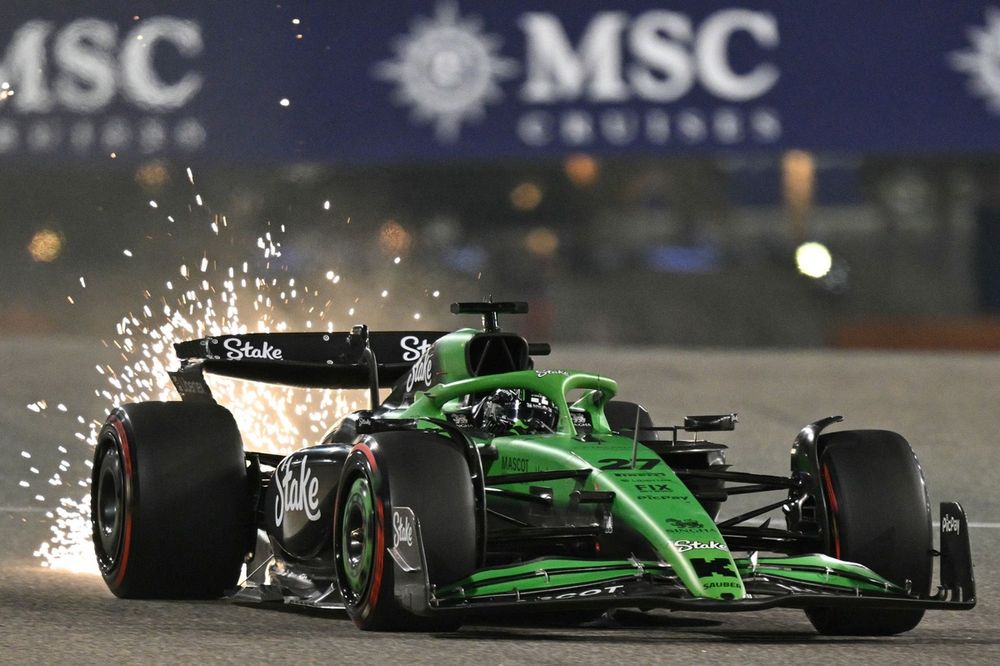Nico Hülkenberg’s Bahrain Grand Prix took an unexpected and frustrating turn after a post-race inspection led to his disqualification. The issue? Excessive wear on the car’s skid block — a rarely discussed but crucial technical component that ensures cars remain within safe height parameters. While he initially crossed the finish line in 13th place, the disqualification struck a blow not just to Hülkenberg, but to Kick Sauber’s broader ambitions in the 2025 season.
This incident has sparked conversations across the paddock and among fans alike, reigniting debates about the rigidity of technical regulations and the challenges teams face in maintaining compliance across variable race conditions.
The Skid Block: Small Part, Big Consequences
At first glance, the skid block — also known as the plank — may seem like a minor part of a Formula 1 car. However, its purpose is anything but trivial. Introduced in 1994 for safety reasons following the tragic events at Imola, the plank is fitted underneath the car to prevent teams from running too low to the ground. A lower ride height can increase aerodynamic performance, but it also raises safety concerns due to increased instability and higher speeds through corners.
According to FIA technical regulations, the skid block must be no thinner than 9mm at any point during or after the race. During the standard post-race checks in Bahrain, the stewards found that the plank on Hülkenberg’s C44 had worn down to 8.4mm on both sides and 8.5mm in the center. The measurements were precise, and the team did not dispute the findings — which left the FIA with no choice but to disqualify him.
Team Kick Sauber Left Baffled
Hülkenberg’s team, Kick Sauber, admitted they were at a loss to explain the breach. Team manager Beat Zehnder expressed visible frustration when addressing the media, acknowledging that while the data was clear, the reasons behind the abnormal wear remained elusive. He hinted at possible setup choices being to blame, but noted the team did not expect such wear levels on a track like Bahrain, which is relatively smooth and not known for aggressive plank wear.

This wasn’t a case of pushing boundaries for competitive edge — it was an unexpected technical oversight, and one that stung deeply.
Hülkenberg echoed similar sentiments. “We didn’t set the car up super aggressively,” he noted. “There wasn’t an obvious reason during the race. Maybe the strong winds or a miscalculation in the rear ride height. But obviously, this isn’t how we wanted to start the season.”
Ripple Effect on an Already Rocky Start
This disqualification compounds a challenging start to the 2025 season for Kick Sauber. The team, which is preparing for its much-anticipated transformation into Audi’s full works team next year, has yet to secure meaningful points this season. Finishing 13th wouldn’t have added to their tally anyway, but the optics of a disqualification at round four are damaging nonetheless.
For Hülkenberg, a veteran driver who remains winless in his F1 career despite strong midfield performances over the years, this incident is yet another reminder of how merciless the sport can be. A driver can execute a clean race, make no mistakes behind the wheel, and still leave empty-handed due to technical irregularities that lie outside his control.
Lessons from the Incident
The incident highlights the fine margins teams walk in today’s Formula 1. With cars designed to be as close to the regulation limits as possible, even small environmental shifts — like temperature, wind direction, or unexpected tire degradation — can cause knock-on effects that result in technical breaches.
In this case, it’s likely a combination of a slightly aggressive setup, the windy conditions on race day, and perhaps a slight miscalculation in rear ride height. But the outcome is clear and unforgiving. Disqualification.
Technical Director at Kick Sauber admitted that the plank wear wasn’t monitored in real-time during the race — a data blind spot they’ll aim to fix for future races. In a sport where milliseconds and millimeters matter, small missteps can have major consequences.
Regulatory Stringency or Fair Play?
While the FIA received some criticism from fans online for the disqualification, most paddock insiders agree that the governing body acted correctly. The rules are clearly defined, and in an era where fairness and safety are non-negotiable, bending regulations for any reason sets a dangerous precedent.
Nonetheless, the situation reignites a deeper debate: Should there be any flexibility in interpreting such minor infringements that don’t necessarily offer performance advantages? Or should F1 stick to its black-and-white application of the rules?
For now, the answer remains firm. The FIA has shown in recent seasons that it is unwilling to compromise on technical violations — as it should be in the name of maintaining competitive integrity.
What’s Next for Hülkenberg and Kick Sauber
The team’s priority now shifts to ensuring that such a misstep doesn’t happen again. With several street circuits and bumpy tracks ahead on the calendar, setup discipline will be more critical than ever. The goal will be to improve real-time data monitoring and to ensure the car’s floor and ride height are optimized not just for speed but for longevity across varying conditions.
For Hülkenberg, the goal remains unchanged: to help develop the car and the team into a competitive force as Audi gears up to enter the grid next year. Despite this disqualification, his experience, racecraft, and consistency remain vital assets for Kick Sauber’s long-term aspirations.
And for fans, it’s a reminder that Formula 1 is as much about engineering precision as it is about driver talent. Every component, no matter how obscure, can decide the fate of a race.
Homebound: Kerala Man Returns After 42 Years Stranded in Bahrain



